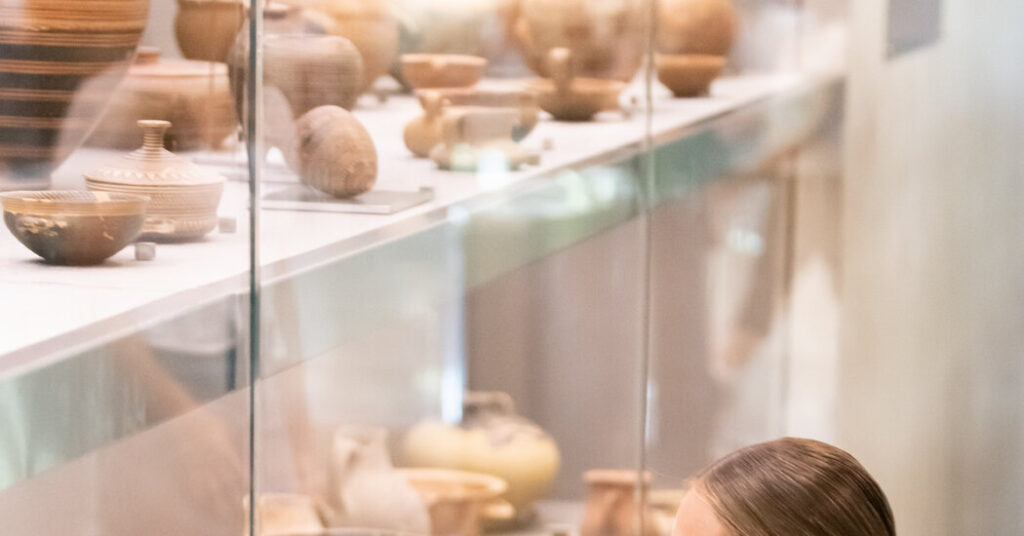Eugenie Niarchos grew up in Paris and now lives in London, but her last name reveals what she says is in her DNA as a jewelry designer: her Greek heritage.
“I love Greece with its mix of antiquities and the modern,” said Ms. Niarchos, 40, “of ancient buildings with the contemporary, all within a natural landscape, in layers, and in harmony.”
She said that love has been reflected in Venyx World, the jewelry brand she introduced in 2013. (“Ven stands for Venus, the goddess of love, while nyx stands for onyx, the black stone, and also for Nyx, the goddess of the night,” she explained — although, of course, Venus is the Roman name for the Greek goddess Aphrodite.)
That inspiration was visible in her recent collection, Hellenic Charms. “I wanted to pay homage to Greece and to Athens,” she said, “to create something that represents my country and my city.”
So she designed eight charms: an Ionic column; a mati, or evil eye; a drachma coin; a Cycladic figure; an amphora; an anchor; a bottle of ouzo; and an elaia, or olive. “Each charm represents a different attribute of Greece,” she said, such as good times, like the ouzo, or business, like the shipping industry represented by the anchor (Ms. Niarchos is a granddaughter of the Greek shipping magnate Stavros Niarchos).
The charms, in 18-karat white or yellow gold and enamel, are sold individually (from $2,930 to $6,650). But they could also be added to the Gold Handmade Link Bracelet or Paperclip Chain Necklace sold on the Venyx World website (prices on application).
Ms. Niarchos frequently travels to Athens and, on a recent visit, she took The New York Times to sites that inspired four of the charms.
Museum of Cycladic Art
Cycladic Sculpture Charm
“This is one of my favorite places, I can spend hours in here,” Ms. Niarchos said as she passed cases displaying artifacts from the Cyclades archipelago dating to the early Bronze Age.
She stopped in front of a case holding a figure, carved in marble, from 2,800 B.C. “The charm is a homage to Cycladic figurines. It’s the female form, representing fertility and the cycle of life, but it’s also a doll-like figure and somewhat playful.
“I love the simplicity of this,” she said, referring to the figure. “The lines are all symmetrical, the proportions are balanced, it’s modern but also classic, and it represents what Athens is all about, the architecture and the art.”
Stoa of Attalos
Drachma Coin Charm
Thousands of years ago, Athenians used to come to the Agora, or city center, to shop in the Stoa of Attalos, a two-level colonnade that housed 42 shops; in other words, a shopping mall. Today, the restored building houses the Museum of the Ancient Agora and its displays of items found in the vicinity, including coins dating back thousands of years.
Ms. Niarchos said she was drawn to the coins by their designs, some of which have the profile of the goddess Athena on one side, and her sacred owl on the other. “Athena resonates with me as a designer,” she said. “She was the goddess of crafts, and her symbol, the owl, represents wisdom and knowledge.” The owl on Ms. Niarchos’s charm has small diamonds for eyes.
Acropolis Museum
Amphora Charm
Ms. Niarchos said the museum, which opened at the foot of the Acropolis in 2009, is “a masterpiece of modern architecture that frames some of the most significant relics of the ancient world.”
Its architecture, by Bernard Tschumi Architects of New York and Paris, was a mix of modern and ancient that resonated deeply with her, and its large collection of ancient artifacts has proved to be an important influence. “It was a key inspiration behind the Hellenic Charms collection,” she said. “It brings together everything I wanted to celebrate: heritage, craftsmanship and identity.”
Case after case of ancient amphoras (large containers usually ceramic) stand at the museum’s entrance. “The different designs date them,” she said. “Some designs are geometrical, others more playful, with symbols of fish or octopuses or people dancing. Some are scenes of battle, of men fighting with bulls.
“My charm is red with a black band showing the Greek key pattern in gold enamel, representing infinity, unity and the cycle of life. My amphora is a celebration of every day life in Athens, of the essentials of living.”
Stavros Niarchos Foundation Cultural Center
Elaia Charm
Almost 10 years ago, the estate of Ms. Niarchos’ paternal grandfather presented a cultural center to the city of Athens.
“It’s a very special place for me,” she said. “It combines culture, nature and architecture in a beautifully thoughtful way. Designed by Renzo Piano, it houses the Greek National Opera and the National Library, set within a public park filled with native plants.” And 400 of them are olive trees.
Recounting the myth that Athena gave the olive tree to the city, Ms. Niarchos noted that the cultural center now makes its own olive oil from the fruit of the trees.
“To me, the olive embodies both the spiritual and the everyday; it’s a perfect balance. It’s what Greece is all about.”
The post Four Places That Helped Shape a Jeweler’s Designs appeared first on New York Times.




